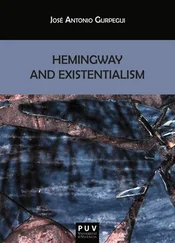Kevin Aho - Existentialism - An Introduction
Здесь есть возможность читать онлайн «Kevin Aho - Existentialism - An Introduction» весь текст электронной книги совершенно бесплатно (целиком полную версию без сокращений). В некоторых случаях можно слушать аудио, скачать через торрент в формате fb2 и присутствует краткое содержание. Год выпуска: 2013, ISBN: 2013, Издательство: Polity, Жанр: Философия, на английском языке. Описание произведения, (предисловие) а так же отзывы посетителей доступны на портале библиотеки ЛибКат.
- Название:Existentialism: An Introduction
- Автор:
- Издательство:Polity
- Жанр:
- Год:2013
- ISBN:978-0745651422
- Рейтинг книги:3 / 5. Голосов: 1
-
Избранное:Добавить в избранное
- Отзывы:
-
Ваша оценка:
- 60
- 1
- 2
- 3
- 4
- 5
Existentialism: An Introduction: краткое содержание, описание и аннотация
Предлагаем к чтению аннотацию, описание, краткое содержание или предисловие (зависит от того, что написал сам автор книги «Existentialism: An Introduction»). Если вы не нашли необходимую информацию о книге — напишите в комментариях, мы постараемся отыскать её.
Existentialism: An Introduction
Existentialism: An Introduction — читать онлайн бесплатно полную книгу (весь текст) целиком
Ниже представлен текст книги, разбитый по страницам. Система сохранения места последней прочитанной страницы, позволяет с удобством читать онлайн бесплатно книгу «Existentialism: An Introduction», без необходимости каждый раз заново искать на чём Вы остановились. Поставьте закладку, и сможете в любой момент перейти на страницу, на которой закончили чтение.
Интервал:
Закладка:
Again, anxiety is not to be reduced to a bio-chemical reaction to a perceived threat. It is not a medical condition but a structure of being human, a basic experience that discloses the nothingness that underlies my everyday being-in-the-world. Existentialists make it clear that anxiety is not to be confused with fear. Fears can be located, understood, and managed because they are always of something; they relate to external objects or things. Anxiety is a fear of nothing , and this why it is so terrifying. I have the unsettling feeling that the meaningful structure of being-in-the-world that holds my identity together is slipping away, but I cannot point to or explain what it is I am anxious about because I am the source of it. Anxiety discloses the fact that it is my identity or being itself that is nothing, that I am not a stable, substantial, and enduring thing, but a ‘ being-possible ,’ a ‘being-toward-death.’ This is why Heidegger says, “So if the ‘nothing’ exhibits itself as that in the face of which one has anxiety, this means that [human existence] itself is that in the face of which anxiety is anxious ” (1962, 187–188). Anxiety, in other words, emerges out of my own structural nothingness, and this I why I cannot point to what is that I am anxious about; it “threatens [from] nowhere ” (186).
The fact that I cannot explain or locate the source of my anxiety makes the feeling all the more horrible, creating a sense of profound helplessness that begets even more anxiety. To defend against this, most of us are able to displace it, turning the overwhelming fear of nothing into a fear of something. In this way, as Kierkegaard puts it, “the nothing which is the object of anxiety becomes, as it were, more and more a something” (1944, 55). Through this displacement, the fear of my own nothingness becomes something ordinary and manageable, transposed into a much less threatening fear of flying, fear of heights, or fear of public speaking. Such displacement allows me to be reabsorbed into the flow of the world, solidifying the illusion of my own being as something enduring and real. But for those with a diminished sense of ontological security, transforming anxiety into fear is not so easy. For such people, anxiety continually “attacks from all directions at once” (May 1950, 2256), and the self is under a constant threat of annihilation.
This experience is characterized by a collapse in the fluid synergy between my body and the world, where even the most basic tasks of everyday life — standing up and moving, reaching out and taking hold of things, and interacting with others — become difficult. Overwhelmed by anxiety, my body loses its transparent grip on the world and begins to obtrude as a brute thing or object, as something clumsy and foreign that inhibits my engagement with the world. Laing describes this experience in terms of ‘the unembodied self.’ “In this position,” he writes, “the individual experiences his self as being more or less divorced and detached from his body. The body is felt more as one object among other objects in the world than as the core of the individual's own being ” (1960, 69). Dissociated from my own body and from the world in this way, I am unable to meaningfully participate in the lives of others. Their gestures, words, and actions appear as lifeless and unreal to me as my own body does. This experience can result in feelings of ‘depersonalization’ where I feel as if I am not actually there and the world is not real (see Fuchs 2005). In this state, I know there is a world out there, but I can no longer feel it . It doesn't resonate emotionally as something substantial, meaningful, or significant to me. For clinicians, patient descriptions of this experience include statements like: “This seems unreal,” “This is like a dream,” “Nothing seems to be touching me,” and “This is not happening” (Laing 1960, 78).
When the world collapses in this way, not only does my identity slip away, but also others now appear to me as a threat because they expose the frailty and uncertainty of my being. When I interact with people who seem to be integrated, substantial, and whole, I am reminded of my own fragile and vulnerable state, that I have to put on a mask when I'm in public in order to “ play at being sane ” (148). To protect against this, the tendency is to withdraw and isolate oneself from others. But isolation further diminishes my sense of self, exacerbating the feeling of unreality. This is because, on the existentialist view, my identity exists only insofar as it is publicly acknowledged. I can understand myself as the person that I am — as a teacher, a husband, or a father — only in relation to how others see me. In other words, who I am and how I interpret myself is constituted by my being-with-others. This is why Sartre writes, “The Other holds a secret — the secret of what I am . He makes me be and thereby possesses me” (1956, 475). Without this inter-human relation, I am cut off from the world and my publicly interpreted identity begins to die. One of the goals of existential therapy, then, is to reestablish a sense of relation with others, to reintegrate the patient back into the public world so that a stable sense of identity can emerge and ontological security can be reestablished. But the primary aim is much more than this. The existential therapist wants the patient to learn from the experience, to recognize that anxiety is not necessarily a sign of insanity or a bio-chemical disorder. It is a teacher that reveals a painful but inescapable truth about the human situation, namely, that we are nothing, that we a re “ not real ” (see Loy 1996). This is a radical way to rethink psychopathology. From the existential perspective, the individual who is overwhelmed with anxiety and experiences the collapse of the world may not be deluded; he or she may actually be glimpsing the truth of the human situation. As Laing writes:
If a man tells us he is “an unreal man,” and if he is not lying, or joking, or equivocating in some subtle way, there is no doubt that he will be regarded as deluded. But, existentially, what does this delusion mean? Indeed, he is not joking or pretending. On the contrary, he goes on to say that he has been pretending for years to have been a real person but can maintain the deception no longer. (1960, 36)
This interpretation exposes the limitations of the medical model. The existential therapist knows that psychiatric techniques may help the patient function, sleep better, and cope with the various stresses of life, but they can never fill the void lying at the core of the human condition. Social psychiatrist Dan Blazer offers his patient Tom as a case in point.
Tom, a law student at a local university, felt the bottom had dropped out of his life three months prior to consulting a psychiatrist. He could not sleep, he had difficulty eating, and his energy was ‘just gone.’ Everything seemed meaningless. Going on seemed useless. … Tom took an antidepressant medication for about six weeks. The antidepressant helped him sleep better and maintain his weight. … When asked in therapy what situations led him to experience [his] symptoms, he answered he felt anxious, lonely, and dislocated when he thought about his life. When asked, ‘What about your life led to these feelings?’ he answered, ‘ Everything yet nothing in particular. ’ (2005, 136–137)
In addition to medication, Tom began sessions of cognitive behavioral therapy with a psychologist to learn how to better manage his distorted thoughts. The pills and cognitive techniques helped him ‘feel better,’ but they could not get at the root of the problem. He continued to describe his experience as “empty” and “meaningless,” as if “the bottom dropped out” of his life, and that “maybe there never was a bottom” (137). This case presents a serious problem for the psychiatrist, because what Tom is going through is not a medical episode, but an ‘existential crisis,’ the all-too-human experience that occurs when “the defenses used to forestall existential anxiety are breached, allowing one to become truly aware of one's basic situation” (138; Yalom 1980, 207). This is where existential therapy breaks with the medical model because it does not seek to diminish or eradicate anxiety, but to confront it, dwell in it, and even increase it .
Читать дальшеИнтервал:
Закладка:
Похожие книги на «Existentialism: An Introduction»
Представляем Вашему вниманию похожие книги на «Existentialism: An Introduction» списком для выбора. Мы отобрали схожую по названию и смыслу литературу в надежде предоставить читателям больше вариантов отыскать новые, интересные, ещё непрочитанные произведения.
Обсуждение, отзывы о книге «Existentialism: An Introduction» и просто собственные мнения читателей. Оставьте ваши комментарии, напишите, что Вы думаете о произведении, его смысле или главных героях. Укажите что конкретно понравилось, а что нет, и почему Вы так считаете.












